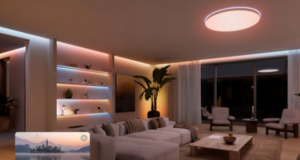
Power tracks are strips designed to allow the positioning of power outlets anywhere across a particular wall. These systems cost more, but go a long way towards reducing dangerous clutter and overloading.

What are power tracks?
Power tracks are a type of power outlet, designed as an alternative to the conventional GPO (General Power Outlet). Instead of offering a single, fixed outlet plate, power tracks use a wall mounted strip, onto which removable outlets can be placed at any point. This type of system can help to do away with the need for external power strips and extension cables, and can help to reduce dangerous cable clutter and power point overloading.
Power tracks are also available which provide access to network cabling and home theatre cabling.
How do power tracks work?
Power tracks are mounted according to the same rules that govern the height and positioning of GPOs, although they only require a single wall penetration through which to run cabling. Three metal conductors (for positive, neutral and earth connections) run the length of the power track.
Adapters are typically connected to the track by inserting the two pins on the removable adapter and then ‘twisting’ to create contact with the concealed conductors. While it is possible to insert small objects into the track openings, because the conductors are well concealed there’s very little chance of electrocution as a result. Most electrical power tracks have IP ratings of around IP2D.
Where can power tracks be installed?
Power tracks can be installed in most parts of the home, but are most convenient in areas where a large number of appliances will be used (for example, in home theatres, living rooms, garages and kitchens). One particular advantage of power tracks is that they allow you to move around furniture without having to worry about how appliances will be positioned. Power tracks can be installed to fit rooms of any size, and can be installed to span corners.
Power tracks aren’t generally appropriate for bathrooms, where the positioning of electrical outlets is significantly limited by safety requirements.
Regardless of where they’re being installed, power tracks (like all other electrical hardware) must be installed by a licensed electrical contractor.
Other considerations
The most obvious disadvantage of power tracks is their cost. They’re far more expensive than GPOs and conventional power strips, however for many people the convenience easily justifies the price. If you’re planning on installing power tracks, be sure to factor in the cost of removable adapters – these can account for a large amount of the overall cost.
If you have lots of appliances with overseas plugs on them, you can normally also pick up removable adapters that will allow you to plug these appliances directly into your power tracks, doing away with the need for external adapters or costly power plug conversions. Remember: it’s illegal to change your own plugs unless you’re qualified to do so!





